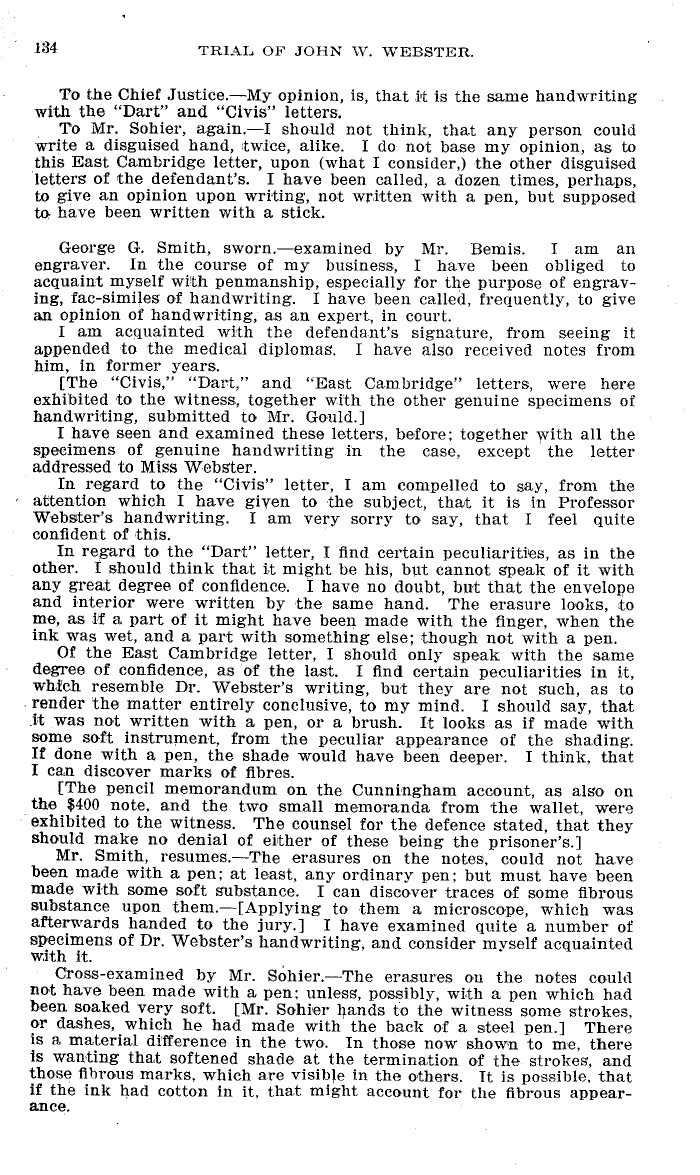|
M4 TRIAL OF JOHN Vi'. WEBSTER.
To the Chief Justice.-My opinion, is, that it is the same handwriting
with the "Dart" and "Civis" letters.
To Mr. Sohier, again.-I should not think, that any person could
write a disguised hand, twice, alike. I do not base my opinion, as to
this East Cambridge letter, upon (what I consider,) the other disguised
letters of the defendant's. I have been called, a dozen times, perhaps,
to give an opinion upon writing, not written with a pen, but supposed
to have been written with a stick.
George G. Smith, sworn.-examined by Mr. Bemis. 1 am an
engraver. In the course of my business, I have been obliged to
acquaint myself with penmanship, especially for the purpose of engrav-
ing, fac-similes of handwriting. I have been called, frequently, to give
an opinion of handwriting, as an expert, in court.
I am acquainted with the defendant's, signature, from seeing it
appended to the medical diplomas. I have also received notes from
him, in former years.
[The "Civic," "Dart," and "East Cambridge" letters, were here
exhibited to the witness, together with the other genuine specimens of
handwriting, submitted to Mr. Gould.]
I have seen and examined these letters, before; together with all the
specimens of genuine handwriting in the case, except the letter
addressed to Miss Webster.
In regard to the "Civic" letter, I am compelled to say, from the
attention which I have given to the subject, that it is in Professor
Webster's handwriting. I am very sorry to say, that I feel quite
confident of this.
In regard to the "Dart" letter, I find certain peculiarities, as in the
other. I should think that it might be his, but cannot speak of it with
any great degree of confidence. I have no doubt, but that the envelope
and interior were written by the same hand. The erasure looks, .to
me as if a part of it might have been made with the finger, when the
ink was wet, and a part with something else; though not with a pen.
Of the East Cambridge letter, I should only speak with the same
degree of confidence, as of the last. I find certain peculiarities in it,
wh'i'ch resemble Dr. Webster's writing, but they are not such, as to
render the matter entirely conclusive, to my mind. I should say, that
it was not written with a pen, or a brush. It looks as if made with
some soft instrument, from the peculiar appearance of the shading.
If done with a pen, the shade would have been deeper. I think, that
I can discover marks of fibres.
[The pencil memorandum on the Cunningham account, as also on
the $400 note, and the two small memoranda from the wallet, were
exhibited to the witness. The counsel for the defence stated, that they
should make no denial of either of these being the prisoner's.]
Mr. Smith, resumes.-The erasures on the notes, could not have
been made with a pen; at least, any ordinary pen; but must have been
made with some soft substance. I can discover traces of some fibrous
substance upon them.-[Applying to them a microscope, which was
afterwards handed to the jury.] I have examined quite a number of
specimens of Dr. Webster's handwriting, and consider myself acquainted
with it.
Cross-examined by Mr. Sohier.-The erasures an the notes could
not have been made with a pen; unless, possibly, with a pen which had
been soaked very soft. [Mr. Sohier hands to the witness some strokes,
or dashes, which he had made with the back of a. steel pen.] There
is a material difference in the two. In those now shown to me, there
is wanting that softened shade at the termination of the strokes, and
those fibrous marks, which are visible in the others. It is possible, that
if the ink had cotton in it, that might account for the fibrous appear-
ance.
|

